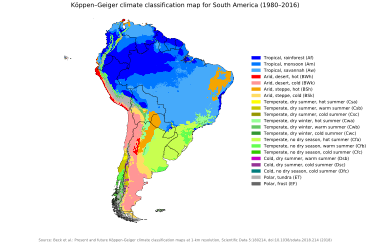
The climate of South America includes all of the major climate zones.
Stuff from the current South America article edit
All of the world's major climate zones are present in South America.[2]
The distribution of the average temperatures in the region presents a constant regularity from the 30° of latitude south, when the isotherms tend, more and more, to be confused with the degrees of latitude.[3]
In temperate latitudes, winters and summers are milder than in North America. This is because the most extensive part of the continent is in the equatorial zone (the region has more areas of equatorial plains than any other region),[3] therefore giving the Southern Cone more oceanic influence, which moderates year round temperatures.
The average annual temperatures in the Amazon basin oscillate around 27 °C (81 °F), with low thermal amplitudes and high rainfall indices. Between the Maracaibo Lake and the mouth of the Orinoco, predominates an equatorial climate of the type Congolese, that also includes parts of the Brazilian territory.[3]
The east-central Brazilian plateau has a humid and warm tropical climate. The northern and eastern parts of the Argentine pampas have a humid subtropical climate with dry winters and humid summers of the Chinese type, while the western and eastern ranges have a subtropical climate of the dinaric type. At the highest points of the Andean region, climates are colder than the ones occurring at the highest point of the Norwegian fjords. In the Andean plateaus, the warm climate prevails, although it is tempered by the altitude, while in the coastal strip, there is an equatorial climate of the Guinean type. From this point until the north of the Chilean coast appear, successively, Mediterranean oceanic climate, temperate of the Breton type and, already in Tierra del Fuego, cold climate of the Siberian type.[3]
The distribution of rainfall is related to the regime of winds and air masses. In most of the tropical region east of the Andes, winds blowing from the northeast, east and southeast carry moisture from the Atlantic, causing abundant rainfall. However, due to a consistently strong wind shear and a weak Intertropical Convergence Zone, South Atlantic tropical cyclones are rare.[4] In the Orinoco Llanos and in the Guianas Plateau, the precipitation levels go from moderate to high. The Pacific coast of Colombia and northern Ecuador are rainy regions, with Chocó in Colombia being the rainiest place in the world along with the northern slopes of Indian Himalayas.[5] The Atacama Desert, along this stretch of coast, is one of the driest regions in the world. The central and southern parts of Chile are subject to extratropical cyclones, and most of the Argentine Patagonia is desert. In the Pampas of Argentina, Uruguay and South of Brazil the rainfall is moderate, with rains well distributed during the year. The moderately dry conditions of the Chaco oppose the intense rainfall of the eastern region of Paraguay. In the semiarid coast of the Brazilian Northeast the rains are linked to a monsoon regime.[3]
Important factors in the determination of climates are sea currents, such as the current Humboldt and Falklands. The equatorial current of the South Atlantic strikes the coast of the Northeast and there is divided into two others: the current of Brazil and a coastal current that flows to the northwest towards the Antilles, where there it moves towards northeast course thus forming the most Important and famous ocean current in the world, the Gulf Stream.[3][6]
Temperature edit
Climate change edit
Precipitation edit
Monsoon edit
Severe weather edit
Tornadoes edit
Tropical cyclones edit
In the continent of South America, northern Colombia and Venezuela have a 1 to 5% chance of a hurricane strike in any given year.[7] In August 1993, Tropical Storm Bret made landfall in Venezuela and killed 173 people.[8] The South Atlantic Ocean is generally inhospitable to the formation of a tropical storm.[9] However, in March 2004, Hurricane Catarina struck southeastern Brazil, becoming the first hurricane on record in the South Atlantic Ocean. Catarina caused $425 million (2004 USD) in damage in Brazil.[10]
References edit
- ^ Beck, Hylke E.; Zimmermann, Niklaus E.; McVicar, Tim R.; Vergopolan, Noemi; Berg, Alexis; Wood, Eric F. (30 October 2018). "Present and future Köppen-Geiger climate classification maps at 1-km resolution". Scientific Data. 5: 180214. Bibcode:2018NatSD...580214B. doi:10.1038/sdata.2018.214. PMC 6207062. PMID 30375988.
- ^ Martyn, Danuta (1992). "The climates of South America". Climates of the World. Translated by Senn, Peter. Elsevier. p. 308. ISBN 0-444-98739-8.
- ^ a b c d e f O CLIMA. In: Atlas Mundial. São Paulo: Cia. Melhoramentos de São Paulo, 1999, pp. 20–21 ISBN 85-06-02889-2
- ^ Landsea, Chris (13 July 2005). "Why doesn't the South Atlantic Ocean experience tropical cyclones?". Atlantic Oceanographic and Meteorological Laboratory. National Oceanographic and Atmospheric Administration. Archived from the original on 16 July 2012. Retrieved 9 June 2018.
- ^ "Wettest Places On Earth By Annual Rainfall". World Atlas. 27 March 2019. Archived from the original on 12 May 2019. Retrieved 12 May 2019.
- ^ "Apresentação da Corrente do Golfo" [Presentation of the Gulf Stream]. knoow.net (in Portuguese). Archived from the original on 11 April 2015. Retrieved 26 January 2017.
- ^ Pielke, Rubiera, Landsea, Fernández, and Klein (2003). "Hurricane Vulnerability in Latin America & The Caribbean" (PDF). National Hazards Review. Archived (PDF) from the original on 2006-08-10. Retrieved 2006-07-20.
{{cite web}}: CS1 maint: multiple names: authors list (link) - ^ Ed Rappaport (December 9, 1993). "Tropical Storm Bret Preliminary Report" (GIF). National Hurricane Center. p. 3. Archived from the original on March 3, 2016. Retrieved August 11, 2015.
- ^ Landsea, Christopher W (July 13, 2005). "Subject: Tropical Cyclone Names: G6) Why doesn't the South Atlantic Ocean experience tropical cyclones?". Tropical Cyclone Frequently Asked Question. United States National Oceanic and Atmospheric Administration's Hurricane Research Division. Archived from the original on March 27, 2015. Retrieved February 7, 2015.
- ^ "Analysis of Hurricane Catarina (2004)" (PDF). Retrieved 2024-02-15.